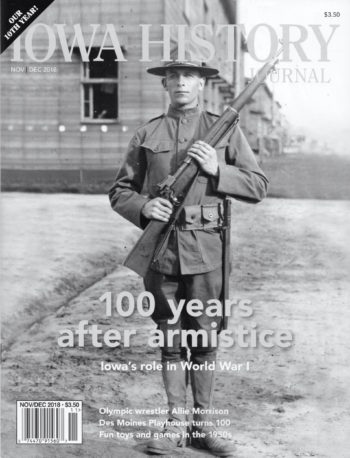
Lawrence P. DeBower, as 23-year-old soldier from Allison, was among the thousands of Iowans who entered the U.S. Army at Camp Dodge in Des Moines in World War I. Courtesy of Iowa Gold Star Military Museum, Camp Dodge.
By John Skipper
It was quite a scene when the Iowa State Fair got underway in August of 1918. Under sunny skies, record crowds totaling 350,000 made their way to the fairgrounds to admire the Belgian horses, enjoy the livestock exhibitions, eat ice cream and take in all the other sights and sounds.
But there was something new this year, something special, something that was likely never to be duplicated. Troops from a nearby U.S. Army training camp, preparing to go overseas to fight in World War I, were also there, drawing the admiration and appreciation from the crowd. And on one particular day, they put on a performance that showed they were ready to go off to France and to “not come back ‘til it’s over, over there,” in the words of the George M. Cohan hit song.
The Des Moines Register reported the event this way. “Iowa’s first regiment, ordered to the front line in France, passed in review before the largest crowd in the history of the Iowa State Fair yesterday afternoon in one of the most impressive military demonstrations ever staged in the state.
“The review was a spectacle not easily forgotten. The platoons broke into a double quick after passing the reviewing stand and reformed in a squad front. When the full 4,000 men were on the track, the entire half-mile was filled with troops and it required a full 15 minutes for the regiment to pass the grandstand.”
Some of the men who participated in that patriotic scene at the fairgrounds went off to Europe the next month and never made it home.
When the United States entered World War I in 1917, the federal government realized there were not enough volunteers to meet the country’s needs in the war effort. So a system was established in which the government required all men between the ages of 18 and 45 to register at their county courthouses, making them eligible to be drafted into the Army.
Each county had a quota it was required to meet. If the quotas were not met by the number of volunteers signing up, the gap was filled by the government drafting enough men to fill them.
Iowa answered the call. The numbers paint a convincing picture of the state’s impact on the war — 114,242 soldiers who left their families, their farms, their businesses to serve their country in “the war to end all wars,” as President Woodrow Wilson called it.
But more devastating than Iowa’s impact on the war was the war’s impact on Iowa. Of those nearly 115,000 who left home, 3,576 were killed. That’s an average of 36 persons per county who gave their lives.
TO READ THE ENTIRE STORY AND OTHER FASCINATING STORIES ABOUT IOWA HISTORY, subscribe to Iowa History Journal. You can also purchase back issues at the store.
